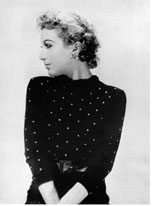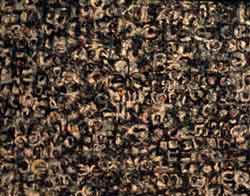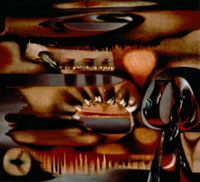|
|
 The life of French surrealist Jacqueline Lamba points to a bad run-in with sexism. Her parents wanted a boy and called her Jacko. She married Surrealist theoretician Andre Breton, who wanted a housewife. She was the subject of numerous portraits by Surrealist greats Picasso, Man Ray, Lam, Masson—but her own work of more than 400 paintings, created over half of a century—went unheralded. The life of French surrealist Jacqueline Lamba points to a bad run-in with sexism. Her parents wanted a boy and called her Jacko. She married Surrealist theoretician Andre Breton, who wanted a housewife. She was the subject of numerous portraits by Surrealist greats Picasso, Man Ray, Lam, Masson—but her own work of more than 400 paintings, created over half of a century—went unheralded.
No wonder Lamba ended up a recluse in her Paris studio, painting her brains out. And no wonder a retrospective of her work at the Salvador Dali Museum in St. Petersburg is titled "In Spite of Everything."
Lamba was so bent on painting that at age 63, she wrote to a friend, "If you hear that I am no longer painting, it is because I have died." She lived another 20 years until 1993, and despite Alzheimer's Disease in the last five years of her life, she went on painting.
Lamba made some compelling paintings, but the label of Surrealism doesn't describe themóparticularly those of the '60s. For that matter, neither does it define Dali. While she left the Surrealist group, he was thrown out of it. And if you take the accepted meaning of "Surrealism" as something intentionally unreasoned, the only thing surreal here is that Lamba's art is showing at the Dali museum.
Her work grew quite non-objective and focused on light. Which would make her a kind of Abstract Impressionist. Vivid strokes of color mark so many of her later works, that the only thing missing is smiling young men dancing with pretty young girls in sun-dappled tea gardens.
"Paysage" (1964) suggests a distant mountain range fronted by a field of flowers, which has the effect of Sisley's "Misty Morning" (1874). They share the same brushwork, the same fragmented strokes of vibrant color with the same softly rendered sky; although Lamba's approach seems less about what the eye sees and more about how it feels to see.
 |
In Spite of Everything (1942)
Oil on canvas |
Even Lamba's early work seems far from Surrealism's tenet: to make form secondary to symbolism. Her "In Spite of Everything" (1942) is chock full of prismatic forms that dominate the space.
 |
Lee Krasner
Untitled (1958)
|
The art movement to which she has the strongest tie may be Abstract Expressionism, most especially Lee Krasner's work. Lamba's "Ville-Paris-Panorama," an undated example, bears a remarkable resemblance to an untitled painting densely packed with an unrelenting repetition of small calligraphic shapes created by Krasner in 1958. Similarities to Krasner's painting can also be seen in Lamba's earlier work; the swirling motion in her "Les Papillons Noirs" (1950) puts one in mind of Krasner's "Cornucopia," which was painted eight years later. The dates suggest who influenced whom.
 |
Behind the Sun (1943)
Oil on canvas, colored pencil |
Certainly the women knew each other, and like Lamba, Krasner was married to a famous man, Jackson Pollock, and suffered similar disregard from the art world.
Not that Lamba or Krasner are exceptions in 20th-century art history. Few know of female artists beyond Mary Cassatt and Georgia O'Keeffe. H.W. Janson's "History of Art," a college level history textbook that was the bible of art students for decades, neglected to mention even these popular artists.
History is full of stories of neglected women artists: from Sofonisba Anguissola, who studied with Michelangelo, and Properzia di Rossi, known for carving entire crucifixions on the pits of cherries. But that's not the way it's always been. The ancient Roman historian Pliny the Elder named several women artists of his time, including Timarete, Eirene, Kalypso and Olympias; although no one mentions them anymore.
But "in spite of everything," in spite of how long it took Lamba to get attention, in spite of the mistagging of her work as surreal, and the inappropriate tying to Dali, art lovers will stand in pleased surprise at the sight of it. |